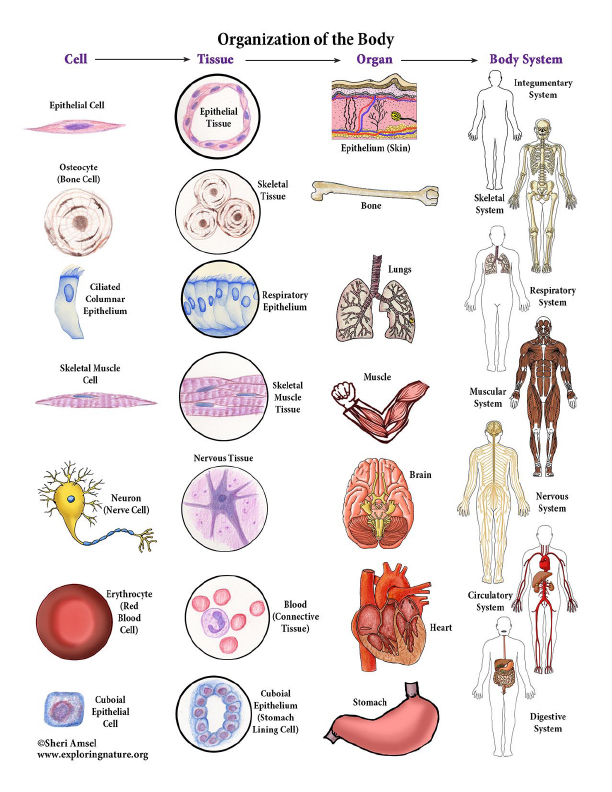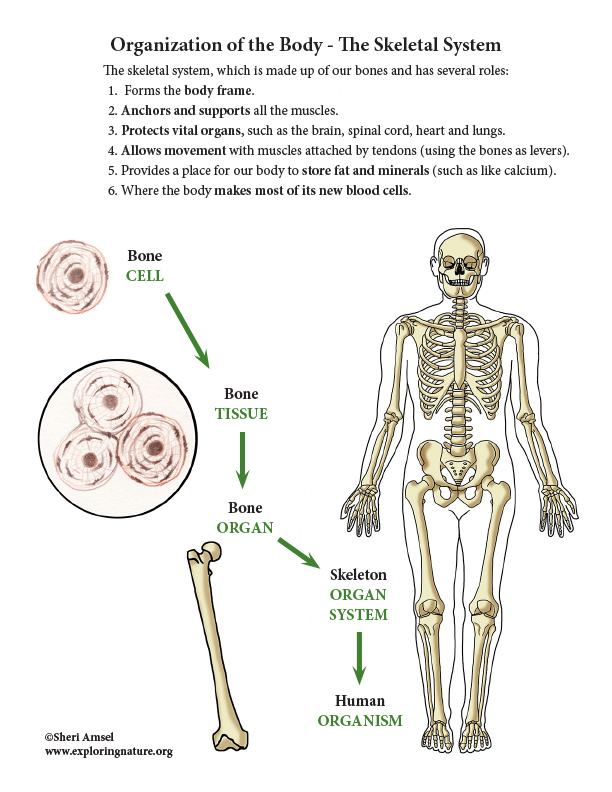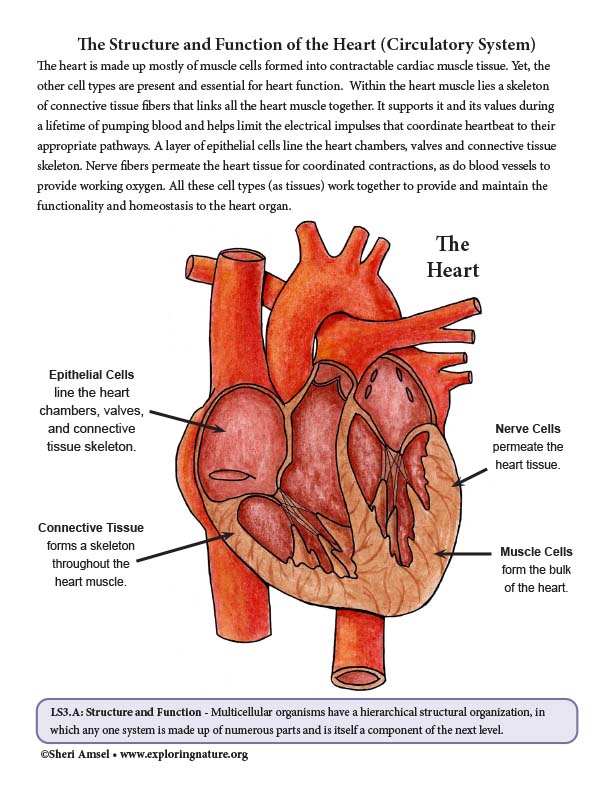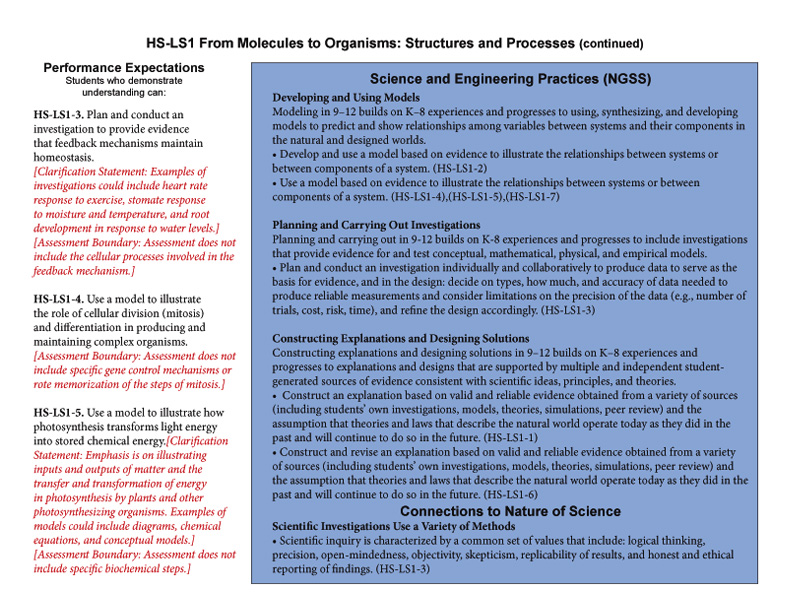

Disciplinary Core Ideas
LS1.A: Structure and Function
• Systems of specialized cells within organisms help them perform the essential functions of life. (HS-LS1-1)
• All cells contain genetic information in the form of DNA molecules. Genes are regions in the DNA that contain the instructions that code for the formation of proteins, which carry out most of the work of cells. (HS-LS1-1) (Note: This Disciplinary Core Idea is also addressed by HS-LS3-1.)
• Multicellular organisms have a hierarchical structural organization, in which any one system is made up of numerous parts and is itself a component of the next level. (HS-LS1-2)
• Feedback mechanisms maintain a living system’s internal conditions within certain limits and mediate behaviors, allowing it to remain alive and functional even as external conditions change within some range. Feedback mechanisms can encourage (through positive feedback) or discourage (negative feedback) what is going on inside the living system. (HS-LS1-3)
_________________________________________________________________________________________________________________________________
Use the Template and Resource Links to Fulfill NGSS
l. Goals:
Essential Questions:
NGSS Note: Think, question, entertain ideas.
__________________________________________________________________________________________________________________________
Living things have common characteristics in their structure and function. Some organisms are more complex than others. The most basic structural units of all living things are cells. An organism can be made up of a single cell (unicellular microorganisms) such as an amoeba or millions upon millions cells (multicellular organisms) as found in plants, animals, fungi, etc.
Large groups of structurally similar cells (specialized calls) form tissues (e.g. skin tissue, muscle tissue, etc). Multiple types of tissues together form organs. And multiple types of organs work together to form functioning organ systems. For example, muscles cells form muscle tissue, which works together with other tissues – epithelial tissue, connective tissue, nervous tissue, etc. to form the heart and blood vessels, which are the organs of the circulatory system. The organ systems (respiratory, digestive, nervous, muscular, skeletal, etc.) each have a specialized function, but are made up of many types of cells and tissues working together for a common purpose (respiration, digestion, movement, support, etc.).
Just as cells support the functioning processes of an organism, there are structures inside cells – the organelles, which support how the cells themselves function. They power the cell, perform chemical reactions, remove waste, and select what can enter and exit the cell.
Within the nucleus, each cell contains DNA molecules wound up into 23 pairs of chromosomes (46 total). On each chromosome is a number of genes which carry the instructions for the development of the proteins. These proteins are the structural components of the body. They also complete and maintain essential life functions, including regulating cellular activities that work to keep the body in homeostasis.
These resources, through reading, illustrated diagrams, investigations, and critical thinking activities will help students with the Next Generation Science Standard: LS1.A: Structure and Function (HS-LS1-1). *For a complete 49-page bundle covering this standard, login as a teacher and click on the Complete Activity Bundle to Help Fulfill this Standard (above), found directly below the sample.
__________________________________________________________________________________________________________________________
ll. Introductory Activities to Assess Prior Knowledge
A. Simple Activities - that assess students’ understanding of cells, organelles and body systems.
lll. New Knowledge - Text
A. Read about cells, the hierarchical structural organization of multicelluar organisms and Feedback Mechanisms:
Connect the Cells to Tissues to Organs to Organ Systems
Tissues - Epithelium, Muscle, Connective Tissue and Nervous Tissue
Levels of Organization in the Body - Cells to Organisms
Structure and Function of the Circulatory System
Structure and Function of the Respiratory System
Structure and Function of the Digestive System
Structure and Function of the Nervous System
Structure and Function of the Muscular System
Structure and Function of the Skeletal System
Structure and Function of the Integumentary System
Feedback Mechanisms Maintaining Homeostasis
Read about genes, DNA and coding for proteins:
Chromosomes, Genes and Traits
The Genetic Code – What Exactly is it?
Important Role of Proteins in… Everything
DNA and Genetics
DNA, Chromosomes, and GenesLocation of DNA, Chromosomes, and Genes
B. Examples of Models (depicts the concept expressed in the reading):
Ask students to look at the models and explain how each illustrates the concepts they've read about.
B. Investigations and Model Making Activities:
DNA Structure and Proteins Synthesis - Info-Poster Making Activity
Feedback Mechanism - Model Building Investigations
DNA to Protein Synthesis - Giant Poster Building
V. Summarize Knowledge - Enduring Understandings
Disciplinary Core Ideas
LS1.A: Structure and Function
• Systems of specialized cells within organisms help them perform the essential functions of life. (HS-LS1-1)
• All cells contain genetic information in the form of DNA molecules. Genes are regions in the DNA that contain the instructions that code for the formation of proteins, which carry out most of the work of cells. (HS-LS1-1) (Note: This Disciplinary Core Idea is also addressed by HS-LS3-1.)
• Multicellular organisms have a hierarchical structural organization, in which any one system is made up of numerous parts and is itself a component of the next level. (HS-LS1-2)
• Feedback mechanisms maintain a living system’s internal conditions within certain limits and mediate behaviors, allowing it to remain alive and functional even as external conditions change within some range. Feedback mechanisms can encourage (through positive feedback) or discourage (negative feedback) what is going on inside the living system. (HS-LS1-3)
Science and Engineering Practices
Constructing Explanations and Designing Solutions
Constructing explanations and designing solutions in 9–12 builds on K–8 experiences and progresses to explanations and designs that are supported by multiple and independent student-generated sources of evidence consistent with scientific ideas, principles, and theories.
• Construct an explanation based on valid and reliable evidence obtained from a variety of sources (including students’ own investigations, models, theories, simulations, peer review) and the assumption that theories and laws that describe the natural world operate today as they did in the past and will continue to do so in the future. (HS-LS1-1)
• Construct and revise an explanation based on valid and reliable evidence obtained from a variety of sources (including students’ own investigations, models, theories, simulations, peer review) and the assumption that theories and laws that describe the natural world operate today as they did in the past and will continue to do so in the future. (HS-LS1-6)
Developing and Using Models
Modeling in 9–12 builds on K–8 experiences and progresses to using, synthesizing, and developing models to predict and show relationships among variables between systems and their components in the natural and designed worlds.
• Develop and use a model based on evidence to illustrate the relationships between systems or between components of a system.
Planning and Carrying Out Investigations
Planning and carrying out in 9-12 builds on K-8 experiences and progresses to include investigations that provide evidence for and test conceptual, mathematical, physical, and empirical models.
• Plan and conduct an investigation individually and collaboratively to produce data to serve as the basis for evidence, and in the design: decide on types, how much, and accuracy of data needed to produce reliable measurements and consider limitations on the precision of the data (e.g., number of trials, cost, risk, time), and refine the design accordingly.
Crosscutting Concepts
Structure and Function
• Investigating or designing new systems or structures requires a detailed examination of the properties of different materials, the structures of different components, and connections of components to reveal its function and/or solve a problem. (HS-LS1-1)
Systems and System Models
• Models (e.g., physical, mathematical, computer models) can be used to simulate systems and interactions—including energy, matter, and information flows—within and between systems at different scales.
Stability and Change
• Feedback (negative or positive) can stabilize or destabilize a system.
Connections to Nature of Science
Scientific Investigations Use a Variety of Methods
• Scientific inquiry is characterized by a common set of values that include: logical thinking, precision, open-mindedness, objectivity, skepticism, replicability of results, and honest and ethical reporting of findings.
Performance Expectations
Students who demonstrate understanding can:
HS-LS1-1. Construct an explanation based on evidence for how the structure of DNA determines the structure of proteins which carry out the essential functions of life through systems of specialized cells. [Assessment Boundary: Assessment does not include identification of specific cell or tissue types, whole body systems, specific protein structures and functions, or the biochemistry of protein synthesis.]
HS-LS1-2. Develop and use a model to illustrate the hierarchical organization of interacting systems that provide specific functions within multicellular organisms. [Clarification Statement: Emphasis is on functions at the organism system level such as nutrient uptake, water delivery, and organism movement in response to neural stimuli. An example of an interacting system could be an artery depending on the proper function of elastic tissue and smooth muscle to regulate and deliver the proper amount of blood within the circulatory system.] [Assessment Boundary: Assessment does not include interactions and functions at the molecular or chemical reaction level.]
HS-LS1-3. Plan and conduct an investigation to provide evidence that feedback mechanisms maintain homeostasis. [Clarification Statement: Examples of investigations could include heart rate response to exercise, stomate response to moisture and temperature, and root development in response to water levels.] [Assessment Boundary: Assessment does not include the cellular processes involved in the feedback mechanism.]








